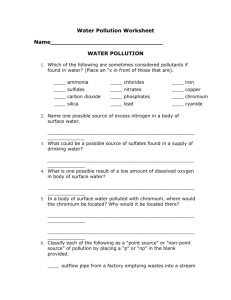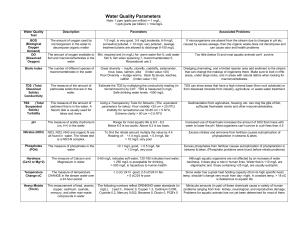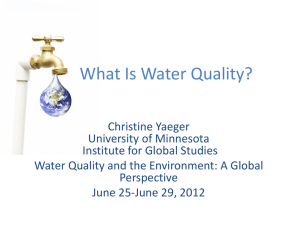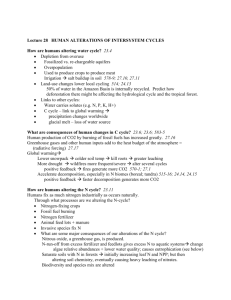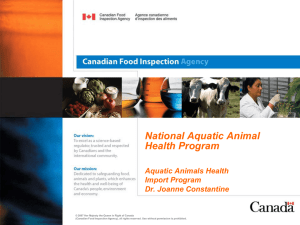Water Pollution-PS &NPS
advertisement
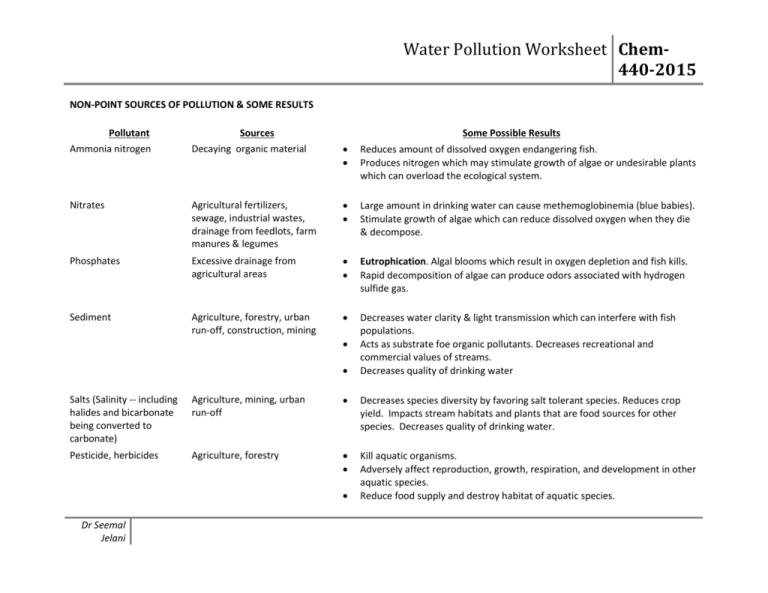
Water Pollution Worksheet Chem440-2015 NON-POINT SOURCES OF POLLUTION & SOME RESULTS Pollutant Ammonia nitrogen Sources Decaying organic material Nitrates Some Possible Results Reduces amount of dissolved oxygen endangering fish. Produces nitrogen which may stimulate growth of algae or undesirable plants which can overload the ecological system. Agricultural fertilizers, sewage, industrial wastes, drainage from feedlots, farm manures & legumes Large amount in drinking water can cause methemoglobinemia (blue babies). Stimulate growth of algae which can reduce dissolved oxygen when they die & decompose. Phosphates Excessive drainage from agricultural areas Eutrophication. Algal blooms which result in oxygen depletion and fish kills. Rapid decomposition of algae can produce odors associated with hydrogen sulfide gas. Sediment Agriculture, forestry, urban run-off, construction, mining Decreases water clarity & light transmission which can interfere with fish populations. Acts as substrate foe organic pollutants. Decreases recreational and commercial values of streams. Decreases quality of drinking water Salts (Salinity -- including halides and bicarbonate being converted to carbonate) Agriculture, mining, urban run-off Decreases species diversity by favoring salt tolerant species. Reduces crop yield. Impacts stream habitats and plants that are food sources for other species. Decreases quality of drinking water. Pesticide, herbicides Agriculture, forestry Kill aquatic organisms. Adversely affect reproduction, growth, respiration, and development in other aquatic species. Reduce food supply and destroy habitat of aquatic species. Dr Seemal Jelani Water Pollution Worksheet Chem440-2015 Polycyclic aromatic hydrocarbons (PAHs) urban runoff Bioaccumulate in tissues of plants, macroinvertebrates and fish. Some are carcinogenic and/or mutagenic. Decrease photosynthesis inaquatic plants. Reduce recreational and commercial activities. Bioaccumulate, biomagnify, and are toxic to aquatic life.( Biomagnification "Biomagnification is the sequence of processes in an ecosystem by which higher concentrations of a particular chemical, such as the pesticide DDT, are reached in organisms higher up the food chain, generally through a series of prey-predator relationships." Can produce carcinogenic metabolites when digested. Polychlorinated biphenyls urban runoff, landfills (PCBs) Toxic to aquatic organisms; can bioaccumulate, biomagnify and be stored in fat deposits. Adsorb to sediments. Persist in environment longer than most chlorinated compounds. Petroleum hydrocarbons urban runoff Water soluble components can be toxic to life. Portions may adsorb to particulate organic matter, be deposited in sediment and may adversely affect biological functions. Silica decomposition of alumina silicate minerals in the drainage basin through which the water flows Forms hard, dense scale (which is resistant to heat transfer) in boilers. Causes loss of turbine efficiency due to deposit of insoluble silica deposits on turbine blades. Sulfates mining, industrial run-off Lower pH in streams which stresses aquatic animals and leaches toxic metals out of sediment and rocks. High acidity and concentrations of heavy metals can be lethal to aquatic organisms and eliminate entire aquatic communities. Dr Seemal Jelani Water Pollution Worksheet Chem440-2015 Sulfides sewage, industrial run-off, paper manufacturing In the form of hydrogen sulfide, cause noticeable odor. Hydrogen sulfide is toxic; acts as a respiratory depressant in humans and fish. Radionuclides mining / ore processing, nuclear power plant wastes, commercial & industry Some are toxic, carcinogenic, or mutagenic. Some degenerate into other substances (e.g., radium and lead) which are toxic and carcinogenic to aquatic organisms. When ingested, they can bioconcentrate in tissues, bones and organs where they emit radiation for a long time. NON-POINT SOURCES OF POLLUTION & SOME RESULTS Pollutant Ammonia nitrogen Sources Decaying organic material Nitrates Phosphates Some Possible Results Reduces amount of dissolved oxygen endangering fish. Produces nitrogen which may stimulate growth of algae or undesirable plants which can overload the ecological system. Agricultural fertilizers, sewage, industrial wastes, drainage from feedlots, farm manures & legumes Large amount in drinking water can cause methemoglobinemia (blue babies). Stimulate growth of algae which can reduce dissolved oxygen when they die & decompose. Excessive drainage from agricultural areas Sediment Agriculture, forestry, urban run-off, construction, mining Dr Seemal Jelani Eutrophication. Algal blooms which result in oxygen depletion and fish kills. Rapid decomposition of algae can produce odors associated with hydrogen sulfide gas. Decreases water clarity & light transmission which can interfere with fish populations. Acts as substrate foe organic pollutants. Water Pollution Worksheet Chem440-2015 Salts (Salinity -- including halides Agriculture, mining, urban run-off and bicarbonate being converted to carbonate) Decreases recreational and commercial values of streams. Decreases quality of drinking water. Decreases species diversity by favoring salt tolerant species. Reduces crop yield. Impacts stream habitats and plants that are food sources for other species. Decreases quality of drinking water. Pesticide, herbicides Agriculture, forestry Kill aquatic organisms. Adversely affect reproduction, growth, respiration, and development in other aquatic species. Reduce food supply and destroy habitat of aquatic species. Bioaccumulate in tissues of plants, macroinvertebrates and fish. Some are carcinogenic and/or mutagenic. Decrease photosynthesis inaquatic plants. Reduce recreational and commercial activities. Polycyclic aromatic hydrocarbons urban runoff (PAHs) Bioaccumulate, biomagnify, and are toxic to aquatic life. Can produce carcinogenic metabolites when digested. Polychlorinated biphenyls (PCBs) urban runoff, landfills Toxic to aquatic organisms; can bioaccumulate, biomagnify and be stored in fat deposits. Adsorb to sediments. Persist in environment longer than most chlorinated compounds Water soluble components can be toxic to life. Petroleum hydrocarbons Dr Seemal Jelani urban runoff Water Pollution Worksheet Chem440-2015 Silica Sulfates Portions may adsorb to particulate organic matter, be deposited in sediment and may adversely affect biological functions. decomposition of alumina silicate minerals in the drainage basin through which the water flows Forms hard, dense scale (which is resistant to heat transfer) in boilers. Causes loss of turbine efficiency due to deposit of insoluble silica deposits on turbine blades. mining, industrial run-off Lower pH in streams which stresses aquatic animals and leaches toxic metals out of sediment and rocks. High acidity and concentrations of heavy metals can be lethal to aquatic organisms and eliminate entire aquatic communities. Sulfides sewage, industrial run-off, paper manufacturing In the form of hydrogen sulfide, cause noticeable odor. Hydrogen sulfide is toxic; acts as a respiratory depressant in humans and fish. Radionuclides mining / ore processing, nuclear power plant wastes, commercial & industry Some are toxic, carcinogenic, or mutagenic. Some degenerate into other substances (e.g., radium and lead) which are toxic and carcinogenic to aquatic organisms. When ingested, they can bioconcentrate in tissues, bones and organs where they emit radiation for a long time. Dr Seemal Jelani
